
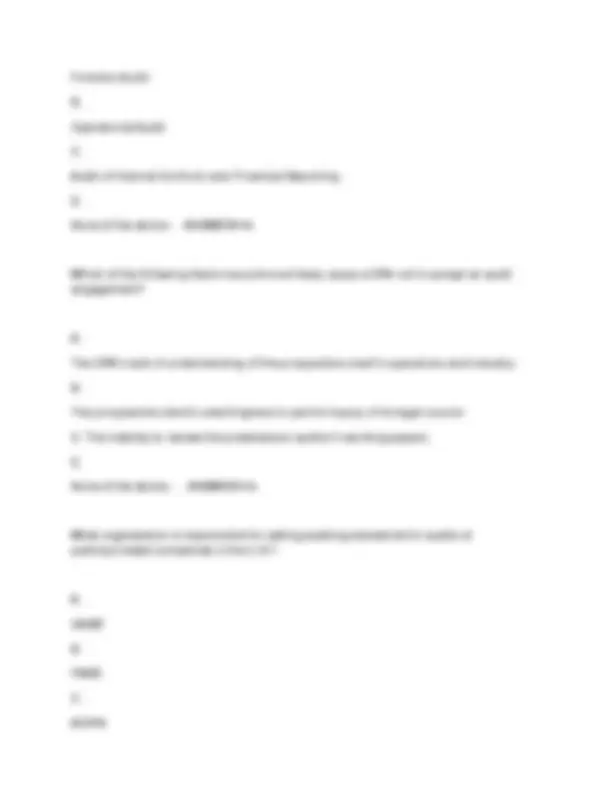
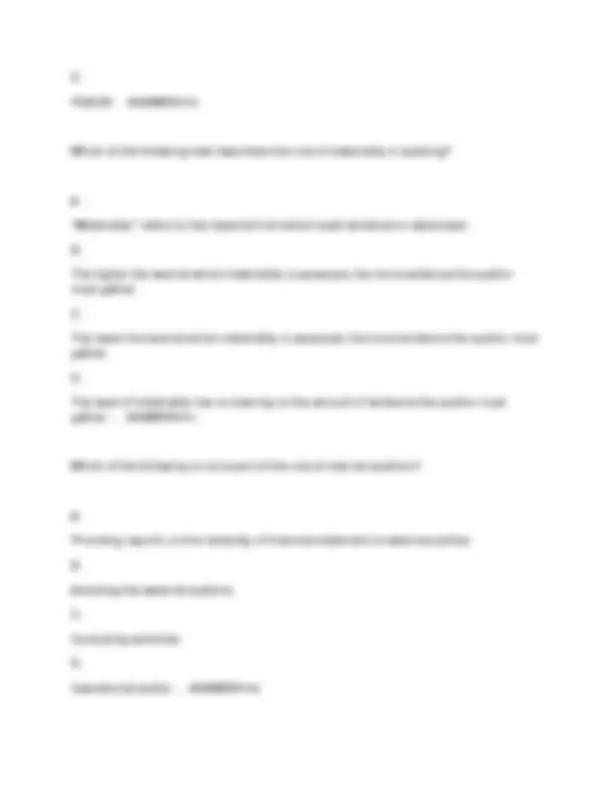
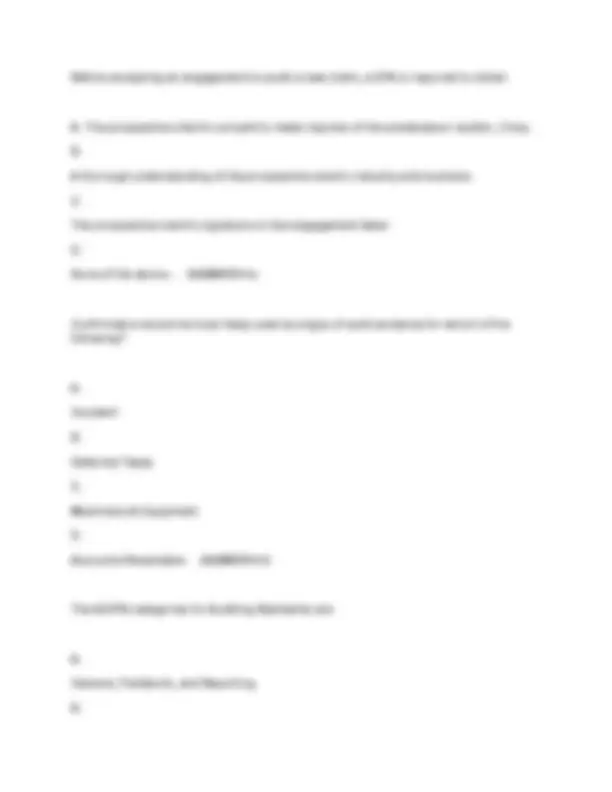
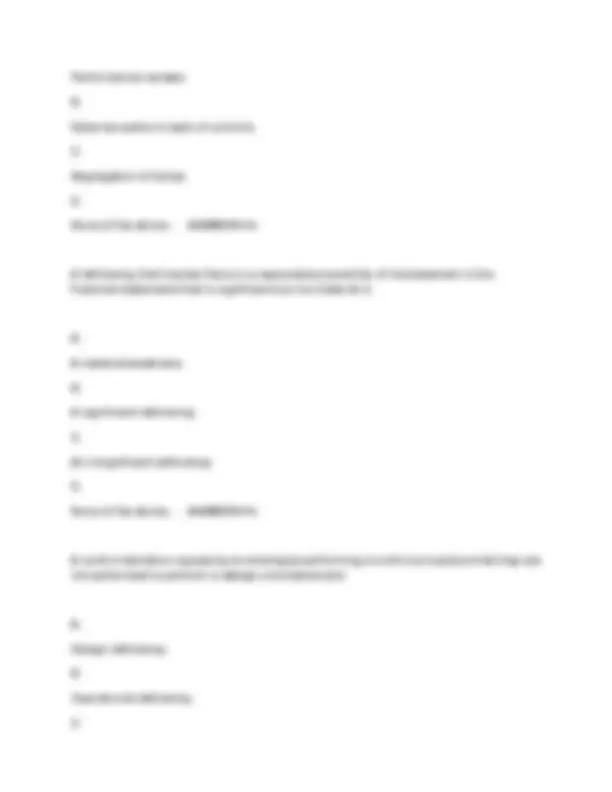
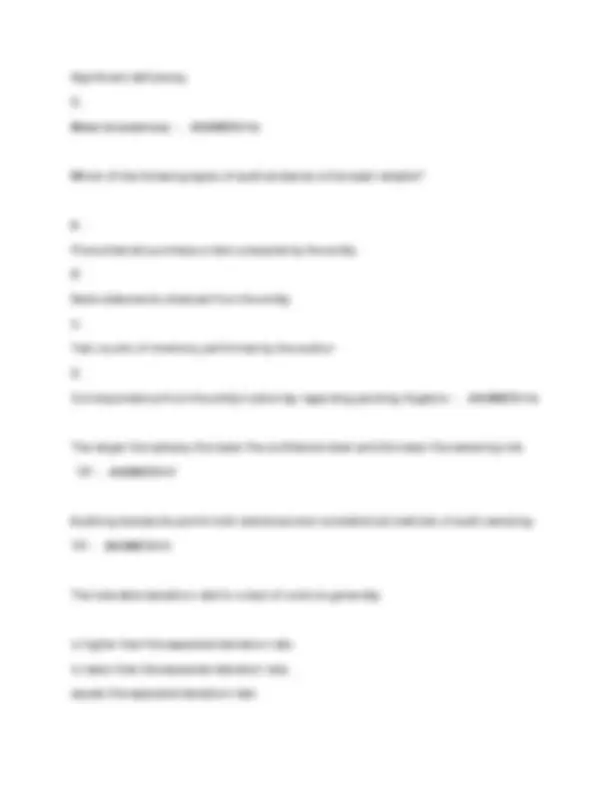
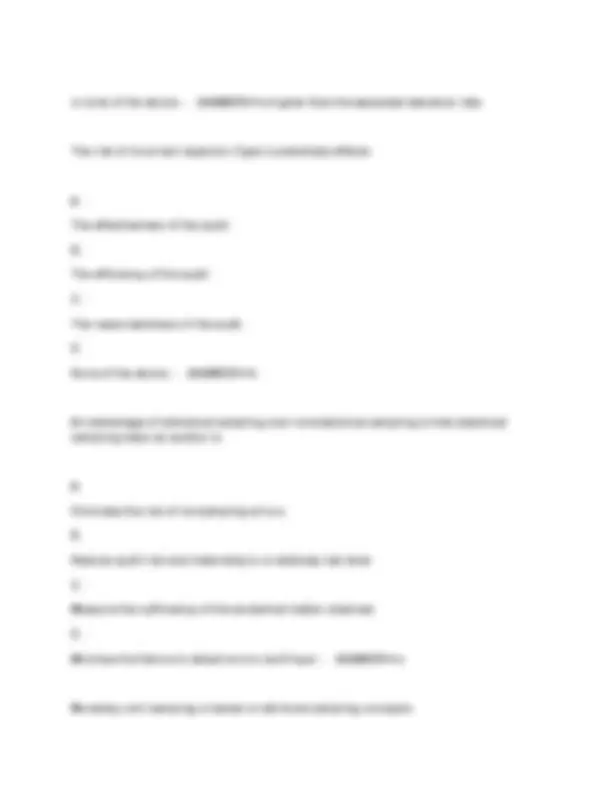
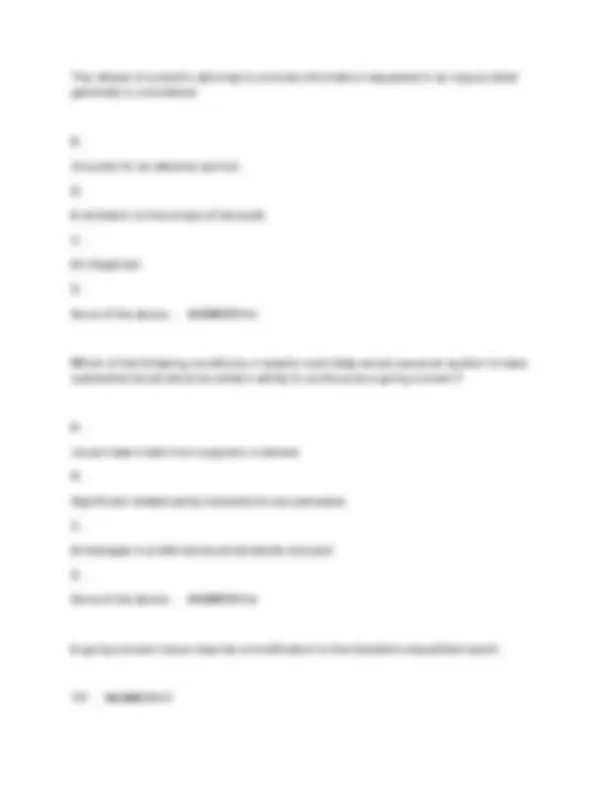
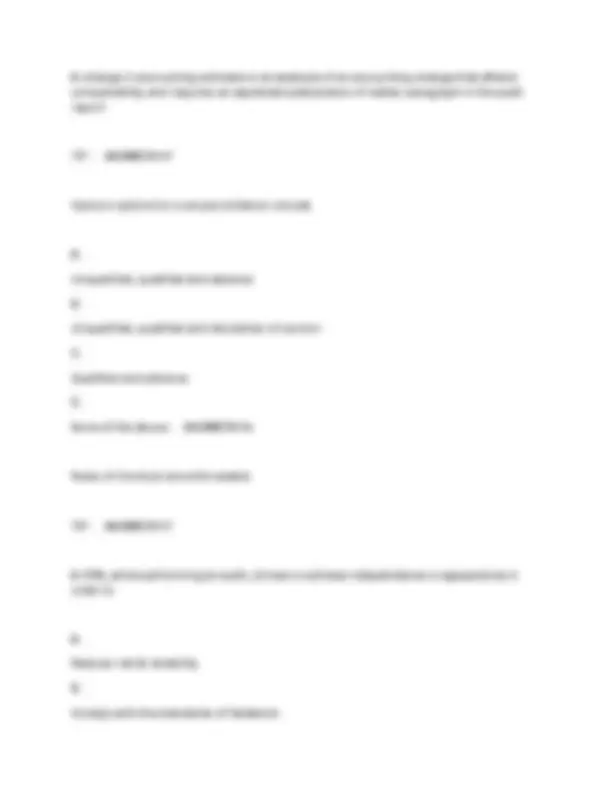
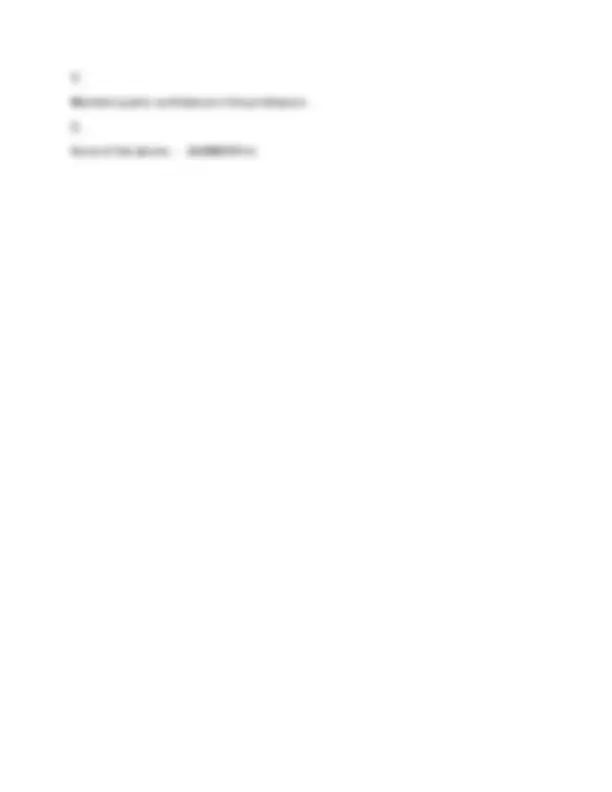


Study with the several resources on Docsity

Earn points by helping other students or get them with a premium plan


Prepare for your exams
Study with the several resources on Docsity

Earn points to download
Earn points by helping other students or get them with a premium plan
Community
Ask the community for help and clear up your study doubts
Discover the best universities in your country according to Docsity users
Free resources
Download our free guides on studying techniques, anxiety management strategies, and thesis advice from Docsity tutors
A series of multiple-choice questions and answers related to auditing standards and practices. It covers topics such as the sarbanes-oxley act, gaas, audit evidence, internal controls, and audit reporting. The questions and answers provide insights into key concepts and principles in auditing.
Typology: Exams
1 / 15

This page cannot be seen from the preview
Don't miss anything!










Prior to the Sarbanes-Oxley Act of 2002, the ____ was responsible for creating all new auditing standards in the U. S.?
A. Financial Accounting Standards Board (FASB) B. AICPA Auditing Standards Board (ASB) C. Securities and Exchange Commission (SEC) D. None of the above - ANSWER>>b
Who is responsible for signing the engagement letter?. Both the client and the auditor. a. The client. B. The auditor. C. Both the client and the auditor. D. None of the above. - ANSWER>>c
Which of the following best describes the general character of the section of GAAS titled "Performance"?
A. Description of the competence, independence, and professional care of persons performing the audit. B. Criteria for the content of the auditor's report. C. Criteria for audit planning and evidence gathering. D. The need to maintain an independence of mental attitude in all audit matters. - ANSWER>>c
Which of the following best describes the relationship between auditing, attest and assurance services?
Attest is a type of audit service. B. Assurance is a type of audit service. C. Auditing is a type of assurance service. D. None of the above. - ANSWER>>c
An auditor evaluating the policies and procedures of the FDA in terms of bringing new drugs to market is an example of which type of audit?
A.
PCAOB - ANSWER>>d
Which of the following best describes the role of materiality in auditing?
A. "Materiality" refers to the material from which audit evidence is developed. B. The higher the level at which materiality is assessed, the more evidence the auditor must gather. C. The lower the level at which materiality is assessed, the more evidence the auditor must gather. D. The level of materiality has no bearing on the amount of evidence the auditor must gather. - ANSWER>>c
Which of the following is not a part of the role of internal auditors?
A. Providing reports on the reliability of financial statement to external parties. B. Assisting the external auditors. C. Consulting activities. D. Operational audits. - ANSWER>>a
Before accepting an engagement to audit a new client, a CPA is required to obtain
A. The prospective client's consent to make inquires of the predecessor auditor, if any. B. A thorough understanding of the prospective client's industry and business. C. The prospective client's signature on the engagement letter. D. None of the above. - ANSWER>>a
Confirmation would be most likely used as a type of audit evidence for which of the following?
A. Goodwill B. Deferred Taxes C. Machinery & Equipment D. Accounts Receivable - ANSWER>>d
The AICPA categories for Auditing Standards are
A. General, Fieldwork, and Reporting B.
COSO stands for
A. Performance reviews. B. External auditor's tests of controls. C. Segregation of duties. D. None of the above. - ANSWER>>b
According to the PCAOB, who is responsible for the reliability of the ICOFR process of an entity?
A. The BOD B. The internal auditors C. The entity's CEO and/or CFO D. None of the above - ANSWER>>c
An entity's control activities do NOT include
A.
Performance reviews. B. External auditor's tests of controls. C. Segregation of duties. D. None of the above. - ANSWER>>b
A deficiency that implies there is a reasonable possibility of misstatement in the financial statements that is significant but not material is
A. A material weakness. B. A significant deficiency. C. An insignificant deficiency. D. None of the above. - ANSWER>>b
A control deviation caused by an employee performing a control procedure that they are not authorized to perform is always considered a(n)
A. Design deficiency. B. Operational deficiency. C.
is none of the above. - ANSWER>>is higher than the expected deviation rate.
The risk of incorrect rejection (Type I) potentially affects
A. The effectiveness of the audit. B. The efficiency of the audit. C. The reasonableness of the audit. D. None of the above. - ANSWER>>b
An advantage of statistical sampling over nonstatistical sampling is that statistical sampling helps an auditor to
A. Eliminate the risk of nonsampling errors. B. Reduce audit risk and materiality to a relatively low level. C. Measure the sufficiency of the evidential matter obtained. D. Minimize the failure to detect errors and fraud. - ANSWER>>c
Monetary-unit sampling is based on attribute sampling concepts.
Monetary-unit sampling is commonly used by auditors to test controls.
T/F - ANSWER>>F
The risk of incorrect acceptance related to the
A. Effectiveness of the audit. B. Efficiency of the audit. C. Planning materiality. D. Allowable risk of tolerable misstatement. - ANSWER>>a
A number of factors influence the sample size for a substantive testing sample. All else being equal, which of the following would lead to a larger sample size?
A. Greater reliance on internal controls. B. Greater reliance on analytical procedures. C. Smaller expected misstatement.
The refusal of a client's attorney to provide information requested in an inquiry letter generally is considered
A. Grounds for an adverse opinion. B. A limitation on the scope of the audit. C. An illegal act. D. None of the above. - ANSWER>>b
Which of the following conditions or events most likely would cause an auditor to have substantial doubt about an entity's ability to continue as a going concern?
A. Usual trade credit from suppliers is denied. B. Significant related party transactions are pervasive. C. Arrearages in preferred stock dividends are paid. D. None of the above. - ANSWER>>a
A going concern issue requires a modification to the standard unqualified report.
T/F - ANSWER>>T
A change in accounting estimate is an example of an accounting change that affects comparability and requires an explanatory/emphasis of matter paragraph in the audit report.
T/F - ANSWER>>F
Opinion options for a scope limitation include
A. Unqualified, qualified and adverse B. Unqualified, qualified and disclaimer of opinion C. Qualified and adverse D. None of the above - ANSWER>>b
Rules of Conduct are enforceable.
T/F - ANSWER>>T
A CPA, while performing an audit, strives to achieve independence in appearance in order to
A. Reduce risk & reliability. B. Comply with the standards of fieldwork.